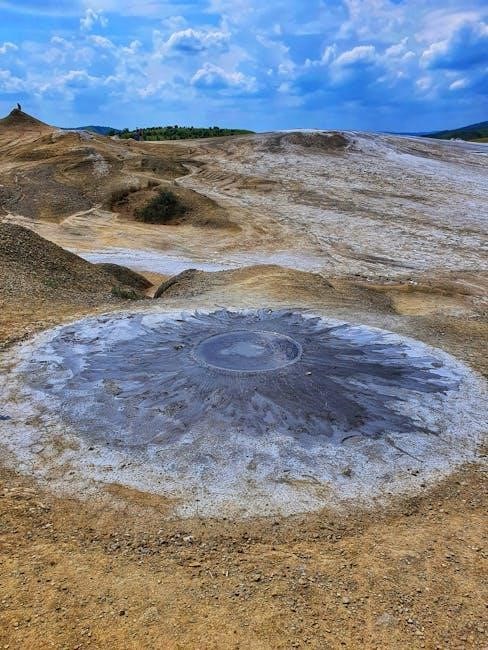AP Environmental Science explores the natural world, focusing on ecosystems, sustainability, and environmental policies. It equips students with critical thinking skills to address real-world ecological challenges effectively.
What is AP Environmental Science?
AP Environmental Science (APES) is a college-level course that explores the natural world, focusing on ecosystems, human impacts, and sustainable solutions. It integrates biology, chemistry, and Earth science to understand environmental systems. Students learn about ecological principles, pollution, climate change, and conservation. The course emphasizes critical thinking, data analysis, and problem-solving skills. It prepares students to address real-world environmental challenges through scientific inquiry and interdisciplinary approaches. APES also includes hands-on labs, fieldwork, and case studies to apply concepts. The curriculum culminates in an exam assessing knowledge through multiple-choice questions and free-response sections. This course is ideal for students passionate about science and committed to understanding and protecting the environment. It aligns with college-level expectations, offering potential college credit for high scores.

Importance of Environmental Science in Today’s World
Environmental science is crucial in addressing today’s global challenges, such as climate change, biodiversity loss, and resource depletion. It provides the knowledge and tools to understand how human activities impact the planet, enabling sustainable solutions. By studying environmental science, individuals gain insights into preserving ecosystems, reducing pollution, and promoting conservation. This field also highlights the interconnectedness of human health, economic stability, and ecological well-being, emphasizing the need for balanced development. As the world faces escalating environmental crises, the principles of environmental science are essential for fostering awareness, driving policy changes, and inspiring collective action. Its relevance lies in equipping societies with the skills to mitigate threats and create a more sustainable future for generations to come.
Overview of the AP Environmental Science Course
The AP Environmental Science course is a comprehensive, two-semester program designed to explore the natural world and human impacts on the environment. It integrates concepts from biology, chemistry, and geography to provide a holistic understanding of ecosystems, conservation, and sustainability. The curriculum covers topics such as environmental systems, pollution, climate change, and resource management, preparing students to address real-world ecological challenges. The course emphasizes critical thinking, scientific inquiry, and the application of environmental principles to everyday life. Students engage in a mix of lectures, labs, and fieldwork to develop practical skills. Assessments include multiple-choice questions, free-response essays, and investigations that evaluate understanding and problem-solving abilities. The course culminates in an exam that tests knowledge and analytical skills, with the goal of fostering environmentally conscious and informed global citizens.

Key Concepts and Topics in AP Environmental Science
AP Environmental Science covers ecosystems, pollution, sustainability, and climate change, emphasizing the interconnectedness of natural systems and human impacts on the environment.
Ecosystems and Ecology
Ecosystems and ecology form the foundation of AP Environmental Science, focusing on the interactions between biotic and abiotic components of the environment. Ecosystems are communities of organisms interacting with their physical environment, and ecology studies these relationships. Key concepts include energy flow through food chains and webs, nutrient cycling, and the balance within ecosystems. Understanding ecosystems helps explain how human activities impact biodiversity and ecosystem services. Topics also cover biomes, such as forests, grasslands, and aquatic systems, and their unique characteristics. The water cycle and its role in sustaining life are emphasized, along with the importance of conservation to maintain healthy ecosystems. Students learn to analyze the structure and function of ecosystems, as well as the consequences of human-induced changes, such as habitat destruction and invasive species. This knowledge is crucial for addressing environmental challenges and promoting sustainable practices.
Environmental Pollution and Its Impact
Environmental pollution refers to the introduction of harmful substances or energy into the environment, causing adverse effects on ecosystems and human health. It is a major focus in AP Environmental Science, as it addresses the types, sources, and consequences of pollution. Air pollution, primarily from fossil fuels and industrial emissions, leads to respiratory diseases and climate change. Water pollution, often due to agricultural runoff and sewage, contaminates drinking water and harms aquatic life. Land pollution, including soil degradation and waste disposal, affects agricultural productivity and biodiversity. Noise pollution disrupts wildlife communication and ecosystems. The impacts of pollution are far-reaching, from human health risks to economic losses. Understanding pollution sources and mitigation strategies is crucial for developing sustainable solutions. Students learn to analyze policies and technologies aimed at reducing pollution, such as clean energy and waste management systems, to promote environmental stewardship and public health.
Sustainability and Conservation Efforts
Sustainability and conservation are central themes in AP Environmental Science, focusing on meeting current needs without compromising future resources. Sustainability involves practices that maintain ecological balance, while conservation emphasizes preserving natural resources. Key strategies include renewable energy adoption, recycling, and sustainable agriculture. Conservation efforts often target biodiversity protection through habitat restoration and wildlife management. Governments and organizations implement policies like carbon emissions reduction and reforestation programs. Education plays a vital role in promoting sustainability by raising awareness of environmental stewardship. These efforts aim to ensure long-term ecological health and resource availability for future generations. By integrating sustainability into daily life, individuals and societies can mitigate environmental challenges effectively.
Climate Change and Its Effects
Climate change refers to significant, long-term alterations in Earth’s climate patterns, primarily driven by human activities like fossil fuel combustion, deforestation, and industrial processes. These activities release large amounts of greenhouse gases, such as carbon dioxide and methane, which trap heat in the atmosphere, leading to global warming. Rising temperatures cause melting of polar ice caps and glaciers, resulting in sea-level rise and increased frequency of extreme weather events like hurricanes, droughts, and wildfires. Ecosystems are disrupted, leading to loss of biodiversity as species struggle to adapt. Climate change also impacts agriculture, causing food shortages and economic instability. Addressing these challenges requires global cooperation, transitioning to renewable energy, and implementing policies to reduce emissions and protect natural resources. Understanding and mitigating climate change is a critical focus of AP Environmental Science, emphasizing sustainable solutions for a healthier planet.
Study Guides and Resources for AP Environmental Science
AP Environmental Science study guides offer detailed explanations, practice questions, and tips for mastering key concepts. Online resources like Quizlet and practice exams enhance preparation and understanding of the subject.
Best Study Guides for AP Environmental Science
Some of the best study guides for AP Environmental Science include comprehensive textbooks like AP Environmental Science: A Study Guide and online resources such as Quizlet. These guides provide detailed explanations of key concepts, practice questions, and tips for mastering the material. They cover topics like ecosystems, pollution, and sustainability, ensuring students are well-prepared for the exam. Additionally, many guides offer strategies for tackling multiple-choice questions and free-response questions effectively. Utilizing these resources can significantly enhance a student’s understanding and confidence in the subject. By leveraging both printed and digital materials, students can create a well-rounded study plan that addresses all areas of the AP Environmental Science curriculum. These guides are essential tools for achieving success in the course and on the exam.
Practice Exams and Past Papers
Practice exams and past papers are indispensable tools for preparing for the AP Environmental Science exam. They provide students with a realistic understanding of the exam format, question types, and time management requirements. Many study guides include practice exams that cover topics like ecosystems, pollution, and sustainability. Additionally, past papers from previous years are available online and can be used to familiarize oneself with the structure and difficulty of the exam. Taking practice exams helps identify weak areas and improves problem-solving skills. By simulating exam conditions, students can enhance their ability to answer multiple-choice questions and free-response questions effectively. Regularly reviewing past papers also allows students to track their progress and refine their study strategies. These resources are essential for building confidence and achieving success on the AP Environmental Science exam.
Online Resources for APES Preparation
Online resources are a cornerstone for effective AP Environmental Science preparation. Websites like Quizlet offer flashcards for key terms, while the College Board provides study guides and practice questions. Many educational platforms host detailed video tutorials and interactive simulations to visualize complex concepts. Additionally, online forums and discussion groups allow students to exchange study tips and clarify doubts. PDF guides and e-books are widely available, offering comprehensive overviews of the curriculum. Utilizing these resources enables students to explore topics like ecosystems and climate change in depth, ensuring a well-rounded understanding. By leveraging online tools, students can enhance their learning experience and achieve academic success in AP Environmental Science.

Strategies for Success in AP Environmental Science
Mastering AP Environmental Science requires effective study habits, strategic time management, and a deep understanding of free-response questions. Utilize study guides, practice exams, and online resources to excel.
Effective Study Habits for APES

Effective study habits are crucial for success in AP Environmental Science. Start by creating a structured study schedule, dedicating specific times to review course material and practice problems. Active learning techniques, such as summarizing key concepts in your own words and engaging with study groups, can enhance understanding. Regularly review and organize notes, highlighting important terms and concepts. Utilize Flashcards for quick recall of vocabulary and processes. Additionally, incorporate digital tools like Quizlet for interactive study sessions. Prioritize understanding over memorization, as this fosters deeper knowledge retention. Regular practice exams help identify areas needing improvement, allowing you to refine your study strategies. Consistency is key—regular, focused study sessions yield better results than last-minute cramming. By adopting these habits, students can build a strong foundation and excel in APES.
Time Management Tips for Exam Preparation
Effective time management is essential for successful exam preparation in AP Environmental Science. Begin by creating a detailed study schedule, allocating specific time blocks for each topic, such as ecosystems, pollution, and climate change. Prioritize challenging areas and break them into manageable sections for focused study. Use time-blocking to dedicate uninterrupted periods to complex concepts, ensuring deeper understanding. Incorporate regular breaks to maintain concentration and prevent burnout. Review notes and textbook chapters consistently, summarizing key points to reinforce retention. Avoid cramming by spacing out study sessions over weeks or months. Practice exams are invaluable for identifying weaknesses and refining test-taking strategies. By adhering to a well-structured plan, students can optimize their preparation and approach the exam with confidence. Consistent effort and targeted focus will yield the best results.
Understanding and Answering FRQs (Free-Response Questions)
Mastering Free-Response Questions (FRQs) is crucial for success in AP Environmental Science. FRQs assess your ability to think critically and communicate complex ideas clearly. Begin by carefully reading the question to identify all parts and requirements. Plan your response by outlining key points and supporting evidence before writing. Address each component of the question directly, using specific examples and concepts learned in class. Use clear, concise language and organize your answer logically to ensure clarity. Scoring often rewards thoroughness, so allocate time to cover all aspects without unnecessary detail. Practice past FRQs to familiarize yourself with the format and improve your writing efficiency. Reviewing the scoring guidelines will help you understand how to maximize your points. Avoid common pitfalls, such as ignoring parts of the question or providing irrelevant information. Regular practice and thoughtful planning are key to excelling on FRQs.
